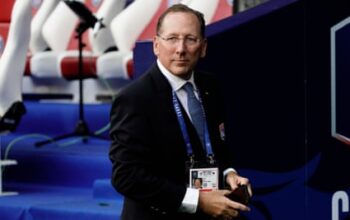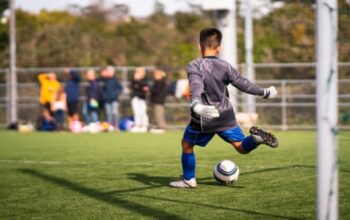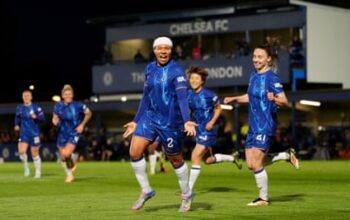An explosion of sheer joy following a lifetime’s worth of disappointment? A not so subtle expression of soft Saudi Arabian power? A wonderful example of the synergy between a city and its football club? Or a Sunderland supporter’s worst nightmare?
Saturday’s celebrations on Newcastle’s Town Moor staged to commemorate Eddie Howe’s team’s Carabao Cup triumph against Liverpool at Wembley two weeks ago was all those things and much, much, more.
If the collection of the team’s first major domestic trophy since the 1955 FA Cup meant different things to different people it was also quite some statement. While around 200,000 fans crammed into a small area of the city centre to watch two open-top buses transport Howe and his players the short distance separating St James’ Park from the Town Moor, a further 150,000 gathered on an expanse of urban green space larger than New York’s Central Park.
Only those who had applied for free, electronic tickets were admitted and, having passed security, they stood from 1.30pm until approaching 8pm, watching a re-run of the final on big screens before being entertained by not only local bands but – inevitably – by Ant and Dec.
A little earlier that ubiquitous pair were aboard the buses conducting interviews relayed on those big screens. As a fan outside St James’ Park sat atop Sir Bobby Robson’s statue, and others balanced on the top of bus shelters or perched precariously up trees, Howe struggled to contain his emotions. “I hoped people would show up but this is unbelievable,” said Robson’s latest successor against a soundtrack of the cheers and “Toon Army” chants echoing well beyond Gallowgate. “I didn’t know what to expect today but it’s incredible. I can’t thank the people of Newcastle enough. It’s very emotional.”
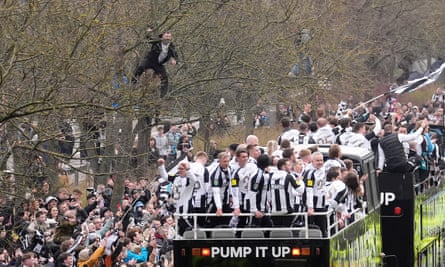
This, though was merely the warm-up for the main event – the moment when Howe and his squad took to the temporary Town Moor stage. It arrived at 6.30pm. By then the broadcasters’ helicopters overhead had filmed the sort of dramatic aerial shots of seething humanity that Newcastle’s Saudi Arabian owners would doubtless see as emphasising their ability to not merely shape a football club but an entire UK city.
When Howe arrived on stage and lifted the cup his smile was as broad as the Tyne. “We’re desperate for more,” said Newcastle’s manager. “When you get a taste of something like this it makes you hungry. Hopefully this is just the start.”
As Newcastle’s players took turns to hoist the trophy a day that had begun with fans queuing outside the club shop at St James’ well before its 9am opening was drawing to a close. No matter that the weather was chilly enough to necessitate supplementing the uniform black and white striped replica shirts with winter coats and woolly hats, this was a city feeling the power of the sun on its back after finally emerging from a footballing ice age.
Although the celebration was ostensibly “dry”, many attendees warmed up with a few drinks in the packed bars of Gosforth and Jesmond, two suburbs within walking distance of the Town Moor.
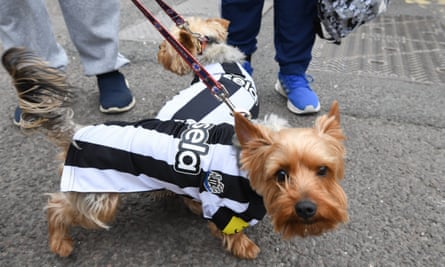
Amid multiple road closures and public transport chaos the city drew, happily, to a standstill as an extraordinary, uniquely monochrome, festival unfolded. Even the mannequins used to promoted the latest spring women’s fashions in the city centre window of Fenwick department store were dressed in black and white.
Outside John Lewis, shoppers queued to have their photographs taken alongside a replica Carabao Cup with the excitement of children waiting for a Christmas audience in Santa’s grotto.
More hardcore, if ticketless, fans milled around St James’ Park as lengthy queues built up around the Town Moor. Attendees frequently encompassed three or four generations of the same family as fans from as far afield as Australia, North America, Kenya and South Korea mingled with locals who view Sunderland as a foreign country.
Back in town, pavements filled with fans already in position for the bus parade, with the more enterprising lining the ramps of an empty car park near the Haymarket in order to gain prime vantage points.
As the sound of vuvuzelas filled the air the front of the Sandman Signature hotel opposite St James’ Park was covered with a giant banner of Howe. Newcastle’s manager could not miss it as, at 4.30pm precisely, the team’s two open-topped buses pulled on to the road and, amid a cacophony of noise and serenaded by a series of flares, the players visibly gasped in awe.
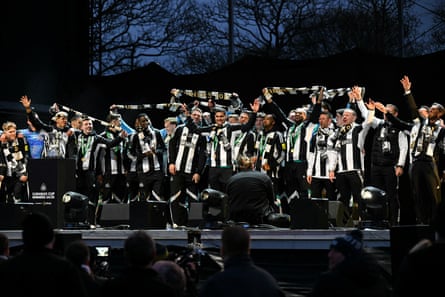
“Oh my God,” said the winger Jacob Murphy. “It’s amazing.” His fellow wide man, Harvey Barnes, did not disagree: “This,” he said, “is something else.”
Fans who witnessed the 1955 FA Cup win were in a minority, with 95-year-old Elsie Burns foremost among them. During a six-month stay in a sanatorium spent recovering from tuberculosis she had held that trophy herself in the course of a morale-boosting visit from Newcastle players.
Seventy years on the mere thought of catching a glimpse of the Carabao Cup provoked delirium as streets blending brutalist 1960s and 1970s architecture with some of the finest Georgian buildings outside Bath became almost alarmingly packed and images of Sandro Tonali, Alexander Isak, Dan Burn, Bruno Guimaraes and the rest of Howe’s heroes stared down from lampposts.
One of the parade buses, a retired London doubledecker with its roof chopped off, failed the first of two MOT tests last week but as it headed to the Moor the engine seemed as finely tuned as Howe’s midfield. “We could get used to this,” reflected Newcastle’s former England centre-forward Alan Shearer, speaking for many. “The last two weeks have probably been the best of my life.”
Source: theguardian.com
